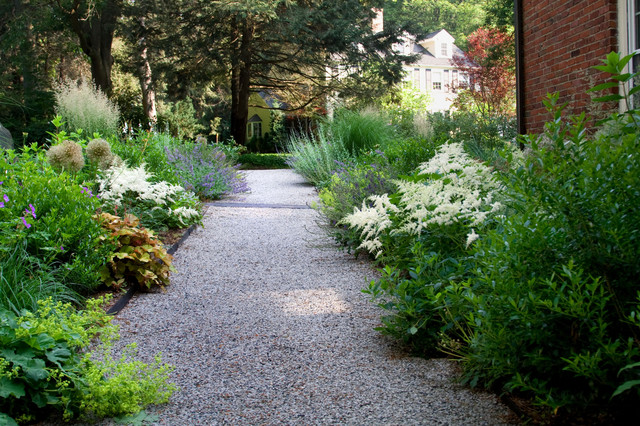7 Reasons Why Gravel Pathways Are Better Than Paving Stones or Concrete
Functionality and aesthetic charm
Gravel pathways have a timeless appeal, offering both functionality and aesthetic charm. While paving stones and concrete are popular choices for pathways, gravel provides a flexible, sustainable, and visually striking alternative. In countries like France, Italy, and Japan, gravel pathways dominate landscapes in everything from grand gardens to minimalist courtyards, showcasing their versatility and cultural significance.
Here are seven reasons why gravel pathways are a superior choice compared to paving stones or concrete.
1. Timeless Aesthetic Appeal
Gravel pathways have a natural elegance that blends seamlessly with any garden or landscape design. Their soft texture and muted tones create a harmonious look that complements both traditional and modern settings.
- French Gardens: Gravel is the hallmark of French formal gardens like Versailles, adding sophistication and charm.
- Italian Courtyards: Italian villas often feature gravel paths that evoke rustic beauty and timeless allure.
- Japanese Zen Gardens: Gravel is an essential element, symbolizing simplicity and balance.
Gravel pathways bring the same timeless beauty to your outdoor space, offering a unique alternative to the rigid lines of paving stones or concrete.
2. Cost-Effective Installation and Maintenance
Gravel pathways are significantly more affordable to install and maintain than paving stones or concrete.
- Lower Initial Costs: Gravel requires minimal preparation and no expensive materials like concrete or specialized stones.
- Easy Repairs: If a section becomes uneven, it’s simple to rake or add more gravel.
- Low Maintenance: Unlike paving stones that can shift or crack, gravel pathways don’t require regular repairs or sealing.
For homeowners on a budget, gravel is a cost-effective way to create beautiful and functional pathways.
3. Sustainability and Permeability
Gravel pathways are an eco-friendly option, offering excellent drainage and reducing environmental impact.
- Permeability: Unlike concrete, which prevents water absorption, gravel allows rainwater to seep into the ground, reducing runoff and the risk of flooding.
- Eco-Friendly Materials: Gravel is a natural material that doesn’t require energy-intensive production like concrete.
- Heat Reduction: Gravel pathways don’t retain heat as concrete does, keeping your outdoor space cooler.
Countries like Japan use gravel extensively in gardens to harmonize with the natural environment, making it a sustainable and mindful choice.
4. Flexibility and Versatility
Gravel pathways are incredibly adaptable, suitable for a wide range of landscapes and styles.
- Customizable Shapes: Gravel pathways can curve and flow naturally, unlike rigid paving stones or concrete.
- Variety of Colors and Textures: Gravel is available in different shades and sizes, allowing you to match your aesthetic vision.
- Easy Expansion: If you need to extend or reshape your pathway, gravel is simple to modify.
This flexibility makes gravel an ideal choice for gardens, driveways, or any outdoor setting.
5. Comfort and Noise Control
Gravel pathways are soft underfoot and naturally absorb noise, creating a tranquil environment.
- Soft Surface: Walking on gravel is gentler than on hard concrete or paving stones, reducing foot fatigue.
- Noise Absorption: Unlike concrete, which amplifies sound, gravel absorbs footsteps, making it ideal for peaceful settings like gardens.
- Safety: Gravel is slip-resistant, providing a safer surface during wet conditions.
These features make gravel pathways particularly suitable for serene landscapes like those seen in Japanese Zen gardens.
6. Durability and Longevity
Gravel pathways are highly durable and stand the test of time, even in high-traffic areas.
- Resistant to Cracking: Unlike concrete, gravel doesn’t crack or shift with temperature changes.
- Self-Healing Surface: Gravel naturally settles and adjusts, maintaining its evenness over time.
- Weatherproof: Gravel can withstand heavy rain, frost, and heat without damage.
Countries like France and Italy rely on gravel in public and private gardens because of its durability and ability to maintain its beauty over decades.
7. Cultural and Historical Significance
Gravel pathways have deep cultural and historical roots, adding a layer of sophistication to any property.
- French and Italian Elegance: The use of gravel in European gardens dates back centuries, symbolizing refinement and grandeur.
- Japanese Simplicity: Gravel’s role in Zen gardens emphasizes tranquility and the connection between humanity and nature.
- Timeless Design: Gravel’s use in these cultures demonstrates its enduring appeal and versatility.
By choosing gravel, you’re incorporating a material with rich historical and cultural significance into your landscape.
Why Choose Gravel for Your Pathways?
Gravel pathways are a practical, sustainable, and visually appealing alternative to paving stones or concrete. Whether you’re inspired by the grandeur of French gardens, the rustic charm of Italian courtyards, or the serene beauty of Japanese landscapes, gravel brings a touch of timeless elegance to your outdoor space.
If you’re ready to transform your garden or driveway, Ascent Yard Care can help with professional pathway design and installation services. Contact us today to explore how gravel pathways can elevate your outdoor living experience.

